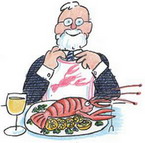![]()

Chicken with Forty Cloves of Garlic
In his Provence:from minstrels to the machine, Ford Maddox Ford tells of a glamorous model who was “one of the best cooks in London”. She loved garlic, “as must all good cooks”, but the intimacy of her work forbade it. She grew desperate. In an act of bravado, she made and consumed an entire Poulet Bearnais, in which a chicken is immolated on a kilo of the forbidden bulb. Her lapse went undetected.
Ford concludes that “she had schooled her organs to assimilate, not to protest against the sacred herb.” He is perhaps being a bit disingenuous. To quote Escudier, “cooked garlic disagrees with no one.” The long cooking would have made all the difference—a kilo of raw garlic on her breath would have emptied the hall.
Much as I love garlic, raw or cooked, a kilo is a bit over the top. The classic Chicken with Forty Cloves of Garlic is about right. My recipe is based on that of the Provencal authority Jean-Noel Escudier, but with the fat and the messiness reduced.
INGREDIENTS
Approx 2 kg / 4 lb chicken
Salt, pepper
Bouquet garni of fresh herbs such as parsley, celery, thyme, bay leaf
Olive oil
Approx 40 cloves of garlic – or more
UTENSIL
Casserole with tight-fitting lid. Best of all is a clay “chicken brick” which holds the bird together without trussing; we never roast a chicken any other way.
INSTRUCTIONS
Cut off the woody bottoms of the garlic cloves, twist each of them hard to loosen the skins and peel them (traditionally they are left unpeeled). Put them in the bottom of your casserole, add a tablespoon of olive oil and stir to coat the garlic.
Salt and pepper the interior of the chicken, rub it generously inside and out with olive oil and insert the bouquet garni. Truss it (if you don’t have a brick or close-fitting casserole) and place it on top of the garlic.
Roast in a 325ºC (Mark 3) oven for 1½ hours and check; it might require another ½ hour or more. The bird should be well browned, there should be lots of juice and the legs should move very freely.
Remove chicken carefully. This is easy with a long-handled wooden spoon inserted in the body cavity. Allow it to rest for up to ½ hour before carving, so that the juices set and don’t all drain away when it’s cut.
Remove the garlic cloves from the casserole with a slotted spoon.
Pour the juices into a fat-separator and allow to settle; then pour into a gravy boat or serving bowl (with some of the olive oil and chicken fat returned, in accordance with taste and conscience).
Serve the garlic separately, to be spread on toast or eaten with the chicken and its juices.
Return to TOP
Return to RECIPE INDEX